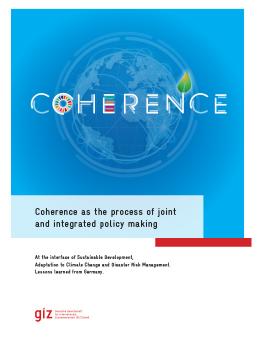
Coherence as the process of joint and integrated policy making
At the interface of Sustainable Development, Adaptation to Climate Change and Disaster Risk Management. Lessons learned from Germany
Coherence as the process of joint and integrated policy making. Lessons learned from a cross-project collaboration to analyze the implementation of global agendas in Germany.
In 2015, the global community adopted the 2030 Agenda for Sustainable Development, the Paris Agreement and the Sendai Framework on Disaster Risk Reduction, all of which have substantial areas of overlap and clear convergence of objectives related to strengthening resilience, fostering sustainable development, and reducing vulnerability to climate change and disasters.
The Sendai Framework and a number of the individual Sustainable Development Goals (SDGs) of the 2030 Agenda mention resilience as the central aspect. Similarly, the Paris Agreement acknowledges the links between climate action and sustainable development while the 2030 Agenda highlights the role of adverse climate change impacts in undermining sustainable development. At the same time, the Sendai Framework recognizes climate change as a driver of disaster risk and that disaster risk reduction (DRR) is essential for sustainable development. Therefore, building strategic linkages and coordinating actions of the three fields could increase the effectiveness of different actions and related goals and should be promoted.
While many governments recognize the value of coherence, they struggle to understand what closer horizontal and vertical integration and coherent policy processes look like in practice and how they can be achieved. Further, research on good examples of coherent policy processes under the different agendas is limited and it does not provide any practical recommendations and lessons learned on the necessary enabling factors and mechanisms that would help create functional linkages for a coherent approach toward the systematic implementation of the global agendas.
To contribute to filling this gap and to support the international community, a cross-project team between IISD and GIZ has set out to explore emerging good practices and practical learnings on fostering coherence. The authors also analyzed the mechanisms and enabling factors that contribute to the development of a coherent approach across different levels of governance in Germany. This case study captures lessons learned and translates them into good practices, which can be applied by decisionmakers in developed and developing countries as well as emerging economies.
The case study showcases how the coherent implementation of the agendas in Germany is based upon a strong political will and underscores the fact that coherence involves considering all administrative levels. Although it has been discovered, that there is no one-fits-all approach to enhancing institutional and policy coherence, the authors identified six good practices based on the German case study, offering valuable insights into what enables post-2015 agenda coherence.
Participating experts
You might also be interested in
COP 29 Outcome Moves Needle on Finance
In the last hours of negotiations, concerted pressure from the most vulnerable developing countries resulted in an improved outcome on the finance target, with a decision to set a goal of at least USD 300 billion per year by 2035 for developing countries to advance their climate action.
What Is the NAP Assessment at COP 29, and Why Does It Matter?
At the 29th UN Climate Change Conference (COP 29) in Baku, countries will assess their progress in formulating and implementing their National Adaptation Plans. IISD’s adaptation experts Orville Grey and Jeffrey Qi explain what that means, and what’s at stake.
The Triple-COP Year: What it means for nature
In 2024, the Rio Conventions on biodiversity, climate change, and desertification will have their negotiations in the same year. We take a look at the implications for nature.
IISD Annual Report 2023–2024
While IISD's reputation as a convenor, a trusted thought leader, and a go-to source on key issues within the sustainable development field is stronger than ever, the work happening outside the spotlight is just as valuable.